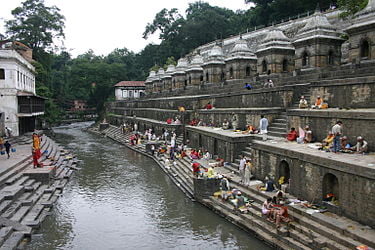Bagmati River

The Bagmati River[n 1] runs through the Kathmandu Valley of Nepal and separates Kathmandu from Patan flowing through the Province No. 2 of Southern Nepal that finally drains into the Indian State of Bihar. It is considered holy by both Hindus and Buddhists. A number of Hindu temples are located on its banks.
The importance of Bagmati also lies in the fact that Hindus are cremated on the banks of this holy river, and Kirants are buried in the hills by its side. According to the Nepalese Hindu tradition, the dead body must be dipped three times into the Bagmati River before cremation, so that the reincarnation cycle may be ended. The chief mourner (usually the first son) who lights the funeral pyre must take a holy river-water bath immediately after cremation. Many relatives who join the funeral procession also take a bath in the Bagmati River or sprinkle the holy water on their bodies at the end of cremation. The Bagmati River purifies the people spiritually.
The Bagmati River is considered the source of Nepalese civilization and urbanization.[2] The river has been mentioned as Vaggumuda (वग्गुमुदा) in Vinaya Pitaka and Nandabagga.[2] It has also been mentioned as Bahumati (बाहुमति) in Battha Suttanta of Majjhima Nikaya.[2] An inscription dated AD 477 describes the river as Bagvati parpradeshe (वाग्वति पारप्रदेशे) and subsequently in Gopalraj Vanshavali.[2]
The Chobar gorge cuts through the Mahabharat Range, also called the Lesser Himalaya. This 2,000-to-3,000-meter (6,600 to 9,800 ft) range is the southern limit of the “middle hills” across Nepal, an important cultural boundary between distinctive Nepali and more Indian cultures and languages, as well as a major geological feature.
